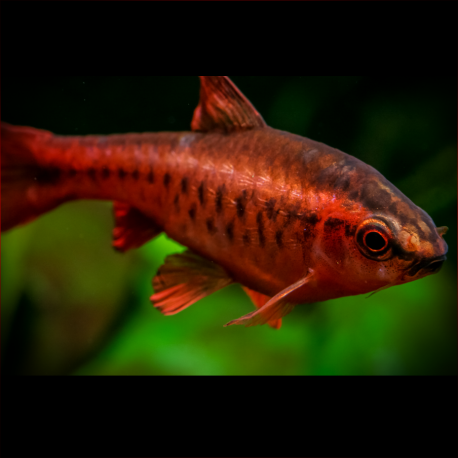More info
Datasheet
| Minimum Tank Size | 60 litres / 15.85 US gallons |
| Maximum Size | 5.0cm / 1.97inches |
| Temperature | 20°C / 68.00°F - 27°C / 80.60°F |
| Hardness | 2.02dgH / 36ppm - 20.00dgH / 357ppm |
| pH | 6.0-7.5 |
General Description
The Cherry Barb (Puntius Titteya) is a popular choice among beginners due to its ease of care and vibrant coloration. It is commonly found in well-established community aquariums and is known for its peaceful demeanor. Selective breeding has resulted in various ornamental strains, including albino and 'super red' forms, maintaining identical care requirements to the standard fish. This species belongs to the Cyprinidae family and falls under the order Cypriniformes.
Aquarium Setup
The Cherry Barb thrives in a densely planted tank with dark substrate, showing enhanced coloration in such environments. It appreciates the addition of floating plants, driftwood, branches, and leaf litter for a natural feel. While filtration need not be robust, some water movement is beneficial for this species, which can also adapt well to a hill stream-type setup. For more details on water conditions, refer to the table provided.
Behaviour
Being a schooling species by nature, the Cherry Barb thrives best in groups of 6-10 individuals. Maintaining them in such numbers reduces skittish behavior and enhances the visual display of the aquarium. Males develop better colors in the presence of conspecific rivals. This species is compatible with a wide range of popular aquarium fish, including tetras, livebearers, rainbowfishes, and catfish.
Feeding and Diet
In the wild, Cherry Barbs are foragers, consuming diatoms, algae, small insects, worms, and crustaceans. In captivity, they readily accept a diet of small live and frozen foods like bloodworms, Daphnia, and Artemia, supplemented with high-quality dried flakes and granules. It is recommended to provide some food containing additional plant or algal content to ensure optimal condition and coloration.
Reproduction & Dimorphism
Cherry Barbs are egg-scattering free spawners, exhibiting no parental care. To maximize breeding results, a separate breeding tank with dim lighting and suitable spawning substrates is recommended. Adult males are slimmer, smaller, and more colorful than females, particularly during spawning. Some ornamental strains have been bred to retain red pigmentation permanently.
Habitat and Distribution
Endemic to Sri Lanka, the Cherry Barb is primarily found in the Kelani and Nilwala river basins within the country's southwestern 'wet zone.' This tropical environment, characterized by constant temperatures of 25-27°C, supports lowland rainforests below 1000 m above sea level. The diminishing forest cover due to human activities poses a threat to the species, with habitat degradation and water quality decline impacting native fish populations. Sympatric species include Rasboroides vaterifloris, Puntius bimaculatus, and Mystus vittatus.
Note: The information provided in this entry is based on research and observations specific to the Cherry Barb (Puntius Titteya).

